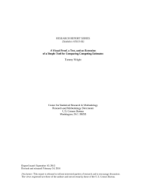A Visual Proof, a Test, and an Extension of a Simple Tool for Comparing Competing Estimates
A Visual Proof, a Test, and an Extension of a Simple Tool for Comparing Competing Estimates
Abstract
A common practice of a national statistical agency (and most scientific investigations) is to assess its estimate for a particular real-valued characteristic (parameter) by comparing it to competing estimates from other sources. The nature of the assessment is to explain the differences. While assessing the quality of energy estimates (e.g., reserves, production, supply, sales, consumption,...), Tsao and Wright (1983) introduced a simple tool (maximum ratio) and used it to prove a statement regarding the closeness of a set containing a particular estimate and competing estimates to the unknown true value of the targeted real-valued parameter. In this paper, we (1) provide a visual proof of the (Main Result), (2) present a test of unacceptability for at least one of the competing estimates using the maximum ratio, (3) give an application assessing the national count from the 2010 U.S. Census, and (4) extend the maximum ratio and statement to vector-valued parameters. The test can be applied in any situation where several measurements of the same phenomenon exist and one wants to quantify with certainty how far away from the truth at least one of the estimates is. Even if all estimates are near each other, this does not necessarily imply that they are near the unknown true value. The test sends a signal calling for further investigation when a pre-set standard is exceeded.
Others in Series
Working Paper
Working Paper
Working Paper




